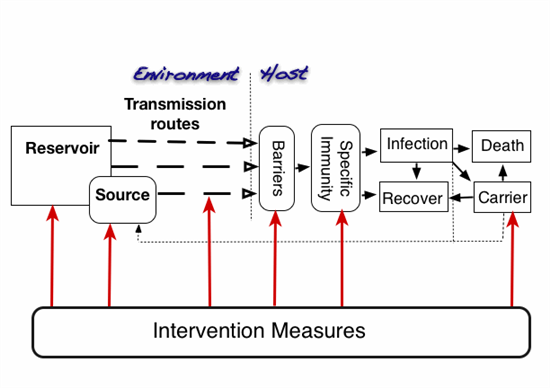Difference between revisions of "Category:Public Health Interventions"
Bosmana fem (talk | contribs) m (→FEM Editor 2007) |
Bosmana fem (talk | contribs) m |
||
| (4 intermediate revisions by the same user not shown) | |||
| Line 1: | Line 1: | ||
Interventions in communicable disease control are by preference, guided by evidence, coming from existing scientific knowledge, and newly generated by [[Assessing the burden of disease and risk assessment|assessment methods for the burden of disease]] and [[Field Epidemiology|field epidemiology]]. | Interventions in communicable disease control are by preference, guided by evidence, coming from existing scientific knowledge, and newly generated by [[Assessing the burden of disease and risk assessment|assessment methods for the burden of disease]] and [[Field Epidemiology|field epidemiology]]. | ||
| − | Interventions are aimed at preventing or interrupting the transmission of an infectious agent to [[hosts]] and | + | Interventions are aimed at preventing or interrupting the transmission of an infectious agent to [[Host|hosts]] and may be proactive (prevention measures) or reactive (control response measures). Each of those measures can be targeted at 'critical control points' in the chain of transmission of infectious agents (see figure). |
[[File:transmissionmodelBosman.png|600px|frame|none]] | [[File:transmissionmodelBosman.png|600px|frame|none]] | ||
| − | For example, measures targeting [[reservoirs]] may include rodent control/extermination in case of leptospirosis or culling of poultry flocks in case of avian influenza. A large portion of control measures | + | For example, measures targeting [[Reservoir for infectious agents|reservoirs]] may include rodent control/extermination in case of leptospirosis or culling of poultry flocks in case of avian influenza. A large portion of control measures includes measures targeted at specific [[Source of infection|sources]], for example, removing botulism-contaminated olives from the market or searching for an infectious tuberculosis patient to treat the infection. |
| − | Examples of measures targeted at [[transmission routes]] include [[vector]] control, | + | Examples of measures targeted at [[transmission routes]] include [[Vector Borne|vector]] control, behavioural education (e.g., safe sex, safe cooking, hand hygiene promotion), and drinking water treatment. Interventions targeting barriers around the [[host]] could include providing personal protective equipment, treatment, and covering skin lesions. Immunizations (vaccinations and prophylaxis through immunoglobulins) are well-known intervention measures to enhance specific immunity against microorganisms. |
| − | Finally, treatment and/or quarantine of infectious patients or carriers | + | Finally, treatment and/or quarantine of infectious patients or carriers ensures that the risk of person-to-person transmission is reduced in certain diseases. |
=Question:= | =Question:= | ||
| Line 35: | Line 35: | ||
: Arnold Bosman | : Arnold Bosman | ||
| − | + | ;FEM Contributors | |
| − | + | : Vladimir Prikazsky | |
| − | + | : Arnold Bosman | |
[[Category:Introduction to Public Health and basic concepts]] | [[Category:Introduction to Public Health and basic concepts]] | ||
Latest revision as of 04:41, 11 July 2023
Interventions in communicable disease control are by preference, guided by evidence, coming from existing scientific knowledge, and newly generated by assessment methods for the burden of disease and field epidemiology.
Interventions are aimed at preventing or interrupting the transmission of an infectious agent to hosts and may be proactive (prevention measures) or reactive (control response measures). Each of those measures can be targeted at 'critical control points' in the chain of transmission of infectious agents (see figure).
For example, measures targeting reservoirs may include rodent control/extermination in case of leptospirosis or culling of poultry flocks in case of avian influenza. A large portion of control measures includes measures targeted at specific sources, for example, removing botulism-contaminated olives from the market or searching for an infectious tuberculosis patient to treat the infection.
Examples of measures targeted at transmission routes include vector control, behavioural education (e.g., safe sex, safe cooking, hand hygiene promotion), and drinking water treatment. Interventions targeting barriers around the host could include providing personal protective equipment, treatment, and covering skin lesions. Immunizations (vaccinations and prophylaxis through immunoglobulins) are well-known intervention measures to enhance specific immunity against microorganisms.
Finally, treatment and/or quarantine of infectious patients or carriers ensures that the risk of person-to-person transmission is reduced in certain diseases.
Question:
What is the difference between preventive, response control, and intervention measures?
Reflection:
In various textbooks and articles, these terms are used in different ways. In the FEMWiki, we prefer the following distinction:
Preventive interventions in communicable disease control:
- Primary prevention: Intervention in the population, targeting healthy population (i.e., not infected) at risk to avoid infection (e.g., immunisations)
- Secondary prevention: intervention in the population infected in order to mitigate symptomatic disease or avoid complications (e.g., screening)
- Tertiary prevention: intervention targeting the population with disease symptoms aimed at limiting the impaired functions in daily life or society due to the disease (e.g., rehabilitation regimes for paralytic polio patients)
In addition to these 3 levels of preventive interventions, a more generic level is often used: primordial prevention, which includes generic measures such as improvements in civil engineering (clean drinking water, sewage systems, etc.).
Communicable disease control response measures that do not include primary, secondary or tertiary prevention are treatment or quarantine of carriers, culling infected poultry flocks, or removing certain food items from the market. However, it is important to be aware that these classifications of prevention are under debate in public health since they do not offer a complete framework for disease prevention and control, and several alternatives have been suggested.
References
Barbara Starfield. Public Health and Primary Care: A Framework for Proposed Linkages. Am J Public Health, 1996 Oct.;86(10):1365–1369. B Starfield, J Hyde, J Gérvas, I Heath. The concept of prevention: a good idea gone astray? J Epidemiol Community Health 2008;62:580–583. doi:10.1136/jech.2007.071027
- FEM Editor 2007
- Arnold Bosman
- FEM Contributors
- Vladimir Prikazsky
- Arnold Bosman
Pages in category "Public Health Interventions"
The following 5 pages are in this category, out of 5 total.
